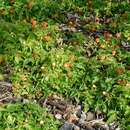Comments
provided by eFloras
The fruit are eaten fresh and used for making jam, jelly, and wine. Whole, young plants are used in medicine.
- license
- cc-by-nc-sa-3.0
- copyright
- Missouri Botanical Garden, 4344 Shaw Boulevard, St. Louis, MO, 63110 USA
Description
provided by eFloras
Subshrubs low, 15–50 cm tall. Rhizomes creeping, woody; stems usually upright, yellowish brown, herbaceous, branched or not branched, obtusely angled, densely pubescent when young, subglabrescent, with sparse, long needle-like prickles. Leaves imparipinnate, 3-foliolate, sometimes 5-foliolate; petiole (2–)3–8 cm, petiolule of terminal leaflet 1–2.5 cm, lateral leaflets subsessile, petiolule and rachis pilose, with straight prickles; stipules lanceolate or linear-lanceolate, 1–1.5 cm, margin entire or shallowly laciniate; lobes linear to lanceolate, pubescent; blade of leaflets oblong or elliptic-lanceolate, rarely ovate-lanceolate, terminal leaflet 5–10 × 1.5–3 cm, base often 2-lobed, lateral leaflets smaller, 2–5 × 1–2 cm, both surfaces glabrous or pubescent only along veins, abaxially with slender prickles along veins, base broadly cuneate to subrounded, margin irregularly serrate, apex acute or obtuse. Inflorescences terminal or axillary, corymbose, 2–3 cm, several flowered, rarely flowers solitary; rachis and pedicels pubescent, with sparse, needle-like prickles; bracts lanceolate or linear, margin entire or laciniate, pubescent. Pedicel 1–2.5 cm. Flowers 1–2.5 cm in diam. Calyx abaxially with dense needle-like prickles, pubescent; sepals narrowly ovate to ovate-lanceolate, 7–10 × 3–6 mm, apex caudate or subulate-acuminate. Petals white, obovate to spatulate, 1–1.3 cm × 5–7 mm, longer than sepals, puberulous, base long clawed, margin entire or incised. Stamens many, shorter than petals; filaments broad, complanate. Pistils shorter than stamens; ovary pubescent near apex; styles glabrous. Aggregate fruit orange-yellow, compressed globose, 1–1.2 cm in diam., glabrous; pyrenes rugose. Fl. May–Jun, fr. Aug. 2n = 14*.
- license
- cc-by-nc-sa-3.0
- copyright
- Missouri Botanical Garden, 4344 Shaw Boulevard, St. Louis, MO, 63110 USA
Distribution
provided by eFloras
Anhui, Gansu, Shaanxi, Sichuan, Yunnan.
- license
- cc-by-nc-sa-3.0
- copyright
- Missouri Botanical Garden, 4344 Shaw Boulevard, St. Louis, MO, 63110 USA
Habitat
provided by eFloras
Roadsides, slopes, forests, rocky ravines; 600--3200 m.
- license
- cc-by-nc-sa-3.0
- copyright
- Missouri Botanical Garden, 4344 Shaw Boulevard, St. Louis, MO, 63110 USA
Synonym
provided by eFloras
Rubus sitiens Focke; R. tibetanus Focke (1909), not Franchet (1886); R. xanthocarpus var. tibetanus (Focke) Cardot.
- license
- cc-by-nc-sa-3.0
- copyright
- Missouri Botanical Garden, 4344 Shaw Boulevard, St. Louis, MO, 63110 USA
Rubus xanthocarpus: Brief Summary
provided by wikipedia EN
Rubus xanthocarpus is a species of flowering plant in the raspberry genus Rubus, family Rosaceae. It is native to central and southern China, and has naturalized in Poland and the former Czechoslovakia. It is available from commercial suppliers. The orange-yellow fruit are edible, taste similar to raspberries, and can be eaten raw or made into preserves or wine.
- license
- cc-by-sa-3.0
- copyright
- Wikipedia authors and editors

